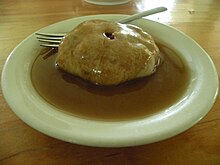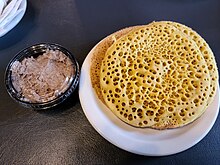
| Cuisine of Quebec |
|---|
 |
Products
|
| Dishes |
| Desserts |
| Acadian foods |
| Regional |
| Part of a series on |
| Canadian cuisine |
|---|
| Regional cuisines |
| Beverages |
| Ingredients |
Styles and dishes
|
| Religious and ethnic |
| Rituals and festivals |
|
|
Acadian cuisine (French: Cuisine acadienne) comprises the traditional dishes of the Acadian people. It is primarily seen in the present-day cultural region of Acadia. Acadian cuisine has been influenced by the Deportation of the Acadians, proximity to the ocean, the Canadian winter, bad soil fertility, the cuisine of Quebec, American cuisine, and English cuisine, among other factors.
Acadian cuisine is not very well known in Canada or internationally. It has much in common with Québécois cuisine because of its geographical proximity. The two often feature the same dishes, but the cuisine of Acadia puts more emphasis on seafood. Acadian cuisine has notably served as the base for Cajun cuisine because the Cajun are descendants of Acadians who were deported to Louisiana. It is also believed that Acadians are responsible for normalizing potato consumption in France—a vegetable the French once considered poisonous.
History
In the 17th century, French colonists who settled on lands they named Acadia adapted their 16th-century French cuisine to incorporate the crops, seafood and animals that flourished in the region. Their descendants became the Acadian people and their ingenuity created Acadian cuisine.
After the English conquered Acadia during the 18th century, they decided to deport the Acadians and take their settlements, which were often built on the most fertile earth in the colony. Most Acadians did not manage to escape the deportation. But, of those who did, most fled to the east and north of New Brunswick. As such, Acadian cuisine in the 18th century was refocused around what could be grown, hunted and fished in the less fertile lands of the East Coast of New Brunswick and the Upper St. John River Valley.
Ingredients
| This section does not cite any sources. Please help improve this section by adding citations to reliable sources. Unsourced material may be challenged and removed. (March 2021) (Learn how and when to remove this message) |
| This section possibly contains original research. Please improve it by verifying the claims made and adding inline citations. Statements consisting only of original research should be removed. (March 2021) (Learn how and when to remove this message) |
Acadian cuisine often features fish and seafood, especially cod and Atlantic herring, but also mackerel, berlicoco, lobster, crab, salmon, mussels, trout, clams, flounder, smelt and scallops. Most fish is consumed fresh, but some are boucané (smoked), marinated or salted.
The most commonly used meat is pork, followed by chicken and beef. As with the rest of North America, turkey is commonly consumed during the Holidays. Game like deer, hare, ruffed grouse and moose is consumed regularly in some regions. Game will replace livestock meat if present and can be given as a gift. In some regions, for example Caraquet and the Îles-de-la-Madeleine, more unusual game is or was caught like seal, bear and seagull.
The vegetables of Acadian cuisine are the potato, onion, carrot, turnip, legume, beet, squash and corn. These vegetables were popular because they were easily preserved for the winter in root cellars and jars. The fiddlehead fern was introduced to the Acadians by the indigenous Maliseet, Mi'kmaq and Penobscot peoples in the early 18th Century and remains a popular Acadian dish.
Popular fruits include blueberries, apples, strawberries, raspberries, blackberries, plums, pears and cranberries.
Some ingredients like rice, molasses, dried raisins and brown sugar are part of Acadian cuisine because of historical commerce between Acadia and regions like the Antilles and Brazil. Maple sugar is also a popular sweetener, given the often-close familial ties between Quebec (the world's largest producer of maple sugar) and Acadia.
Dishes
| This section needs additional citations for verification. Please help improve this article by adding citations to reliable sources in this section. Unsourced material may be challenged and removed. Find sources: "Acadian cuisine" – news · newspapers · books · scholar · JSTOR (August 2022) (Learn how and when to remove this message) |



Some examples of traditional Acadian dishes are:
- Beurre de homard—lobster butter
- Bouilli Acadien—a boiled dinner consisting of potatoes, salted beef or pork, carrots, green beans, cabbage and turnips.
- Bouillie à la viande salée
- Bouillon aux coques
- Chiard/Mioche—purée of potatoes, carrots and/or turnips.
- Chow-Chow— a North American pickled relish.
- Cipâte—sea-pie
- Coques frites—fried clams
- Coquille Saint-Jacques—a sea scallop dish.
- Cretons—a type of boiled, ground pork pâté.
- Croquettes de poisson—fishcake.
- Doigt-à-l'Ail—garlic finger
- Fricot—a type of stew, consisting of potatoes, onions, and whatever meat was available, topped with dumplings.
- Morue bouillie avec patates et beurre fondu—cod and pan-fried potatoes in butter.
- Pain au homard—a lobster and mayonnaise sandwich.
- Pâté au poisson—fish paste.
- Pâté chinois—mashed potatoes, ground beef and creamed corn.
- Pets de sœurs—" pastry filled with butter and brown sugar, rolled, sliced and baked.
- Ploye—pancake-like mix of buckwheat flour, wheat flour.
- Pouding chômeur—poor man's pudding.
- Poutine râpée—boiled potato dumpling with a pork filling.
- Poutine à trou—baked apple dumplings.
- Poutine au bleuet—French fries with cheese, gravy, and blueberries.
- Ragoût—a thick kind of soup.
- Rappie pie/Râpure—grated potatoes and chicken or salted pork.
- Soupe aux pois—Canadian pea soup.
- Tarte au sucre acadienne—acadian sugar pie.
- Tchaude—fish chowder.
- Tourtière: meat pie.
See also
Notes
- 1. When one speaks about Acadia before the Deportation of the Acadians, they are referring to the Acadia colony owned by France, which is today the Maritime region of Canada. When one refers to Acadia in the present tense or after the Deportation of the Acadians, they are referring to the regions where Acadians live today. The Acadia of today is the north and east of New Brunswick, and some small parts of Prince Edward Island and Nova Scotia. Acadia, while not always recognized as such, can be considered a nation because of the language, culture, institutions, symbols, territory and history its people share.
- 2. Louisiana is not the only place outside of Canada where many people of Acadian descent can be found; there is also France, the Falkland Islands, the Antilles, New England and Texas.
- 3. A few Acadians also fled to sections of Cape Breton, western Nova Scotia and south Prince Edward Island. Because of their relative distance from New Brunswick, these communities experienced their own challenges and developed some unique dishes. Some also escaped to New France (now Québec) and assimilated to the Canadien population.
References
- "9 Acadian Foods You Have to Try in New Brunswick". Tourism New Brunswick. 2018-05-18. Archived from the original on 2020-05-16. Retrieved 2020-05-19.
- "Acadian Culture in Maine".
- "13 Classic Acadian Recipes | Food Network Canada". foodnetwork.ca. Retrieved 2020-05-19.
- "La Deportation des Acadiens" (consulted 14 January 2021)
- "Madawaska, "Acadian Food"".
- "Lobster Butter". Dining and Cooking. 2015-07-18. Retrieved 2021-03-18.
- "History and Culture: Bouilli". 18 October 2017.
- "Le Québec Cuisine | Depuis 12 000 ans !". www.quebecuisine.ca. Retrieved 2021-03-18.
- "Coques en bouillon d'herbes et petits légumes". Marie Claire (in French). Retrieved 2021-03-18.
- "How to Make Coquilles Saint-Jacques". Allrecipes. Retrieved 2021-03-18.
- "Cretons".
- "Pain à l'ail". Cuisinez! (in Canadian French). Retrieved 2021-03-18.
- "Morue et pommes de terre poêlées au beurre". recettessimples.fr (in French). Retrieved 2021-03-18.
- Lamoureux, Mélodie (7 September 2018). "Cette poutine aux bleuets est l'ultime raison pour faire une virée au Saguenay". Recettes du Québec. Retrieved 2021-03-18.
- "Tchaude" (consulted 11 February 2021)
Bibliography
- Marielle Cormier Boudreau and Melvin Gallant, La Cuisine traditionnelle en Acadie : historique des traditions et coutumes culinaires chez les Acadiens du Nouveau-Brunswick, de la Nouvelle-Écosse, de l'Île-du-Prince-Édouard et des Îles-de-la-Madeleine, Moncton, Éditions d'Acadie (réimpr. 1980, 1987) (1re éd. 1975), 181 p.
- Ghislain Savoie, Histoire de la pomme de terre et autres tubercules connus dans l'ancienne Acadie, Les Cahiers, Société historique acadienne, vol. 42, no 1, March 2011, p. 4-25
| Acadia | |
|---|---|
| History | |
| People and culture | |
| Institutions | |
| Related | |
| Provinces | |